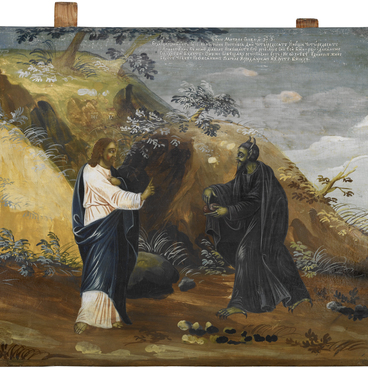The iconography of the Forty Martyrs of Sebaste is based on the story of the heroic feat of Christian soldiers in 320 in Sebaste, which is in modern Turkey. They served in the Roman Legio XII Fulminata (Armed with Lightning) under the Emperor Licinius. When their commander Agricola ordered them to worship the pagan gods and the soldiers refused, as a punishment, they were stripped naked and driven unto a frozen lake. For those who would renounce Christ, a warm bath was prepared on the shore. Only one succumbed, but he died as soon as he entered the room to warm himself up. One of the guards, on the contrary, joined the condemned. The legend had it that the ice had melted by the daybreak, and 40 crowns shone over the martyrs in the sky. Then, the Romans crushed their legs and burnt them. The pagans cast the bones into the lake, so that the Christians could not bury anyone. However, as the bones glowed in the water, and three days later Peter, the bishop of Sebaste, managed to gather the relics up and have them buried the Christian way.
The Forty Martyrs of Sebaste
Creation period
1724
Dimensions
62,5x49,7 cm
Technique
Wood, tempera
Collection
Exhibition
2
Open in app#1
Unknown Author
The Forty Martyrs of Sebaste
#2
#3
About icon
#4
The icon from the collection of the Rybinsk Museum Reserve was painted in 1724 — that exact year is noted on the image itself. The unknown author created the image in the spirit of his times: art was dominated by the Baroque style then. It can be seen in the icon – multiple figures, decorative effect and bright, deep colours. The artist used the single point perspective, typical of secular painting, and portrayed the distance realistically. However, the manner of image painting, i.e. painting of faces and open parts of the body, as well as a simplified presentation of architectural forms, was in line with the traditions of Old Russian icon painting.
The image is painted on wooden boards bonded together. The surface is polished and covered with the levkas, a mixture of chalk and glue. Unlike in earlier icons, there is no cutback centre part of the panel. Iconographers from the 18th century onwards marked the margins only in colour. They used tempera paints made of powder pigments mixed with raw egg yolk. Having kept yolk in warmth to make it lose its viscosity before mixing a paint, they diluted it slightly with kvas or water.
The bottom part of the icon is decorated with a cartouche, a decorative scroll with monograms. It briefly describes the feat of the soldiers of Sebaste.
The image is painted on wooden boards bonded together. The surface is polished and covered with the levkas, a mixture of chalk and glue. Unlike in earlier icons, there is no cutback centre part of the panel. Iconographers from the 18th century onwards marked the margins only in colour. They used tempera paints made of powder pigments mixed with raw egg yolk. Having kept yolk in warmth to make it lose its viscosity before mixing a paint, they diluted it slightly with kvas or water.
The bottom part of the icon is decorated with a cartouche, a decorative scroll with monograms. It briefly describes the feat of the soldiers of Sebaste.
#5
Rybinsk Museum Reserve
read morehide
00:00
00:00
1x
The Forty Martyrs of Sebaste
Creation period
1724
Dimensions
62,5x49,7 cm
Technique
Wood, tempera
Collection
Exhibition
2
Open in app
Share

